Thermal insulation of pipes: the fight against freezing and
Thermal insulation of pipelines of heat networks, as well as water supply and drainage systems is practically obligatory. This is due to the fact that when moving through the pipes, their contents can either be exposed to low temperatures (there is a risk of freezing) or lose thermal energy.
To avoid this, experts use a variety of methods, the most popular of which will be discussed in our article.
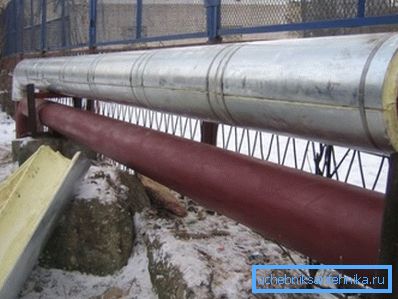
Basics of insulation
The need to perform work
All measures to insulate pipelines are carried out with one specific goal - to reduce the influence of external factors on the contents of pipes.
However, depending on the situation, the nuances may vary:
- If we are talking about heating and hot water supply, then it is necessary to minimize energy losses during transportation of the coolant.. While the hot water reaches the pipeline from the boiler room to the house (especially in winter), it will cool down by about 10-150C. Accordingly, financial losses will also be considerable.
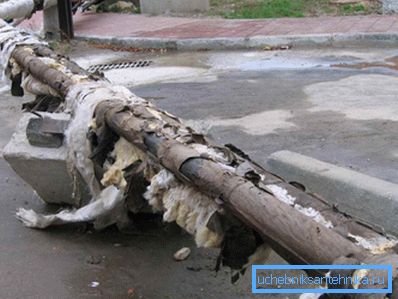
- In addition, heat insulation of hot water pipes in residential and industrial premises is also important.. It is mounted in order to protect people from burns when in contact with the heated walls of the communication circuits.
- With cold water and sewage system, we have a slightly different problem.. When the temperature of atmospheric air decreases, the risk of freezing of the liquid in the pipes increases, which at the early stages leads to a weakening of the pressure, and then to a complete blockage.
- If you try to use a system in which an ice block has formed, a pipe may break. with all the ensuing (in the literal and figurative sense) consequences.
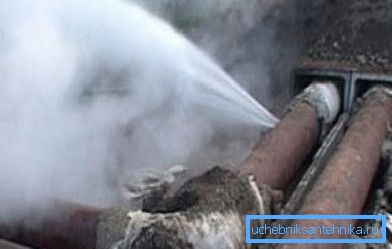
Actually, the methods described below are used to solve these three problems.
Approaches to solving the problem
Protect pipelines from temperature extremes and external influences in several ways:
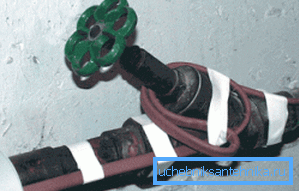
- First, the sewer pipelines (faecal and storm sewers), as well as the water supply system can be equipped with active heating systems. Such systems are heating cables that are either mounted on top of a pipe, or inserted into its lumen and connected to the electrical grid.
Note! When used continuously, the manual recommends the use of self-regulating wires that do not overheat and do not burn out, because they are automatically disconnected when excessive heating occurs.
- Secondly, pipes can be laid in such a way that they have minimal contact with low temperatures. Usually for this purpose all communications are buried in the ground below the level of its freezing.
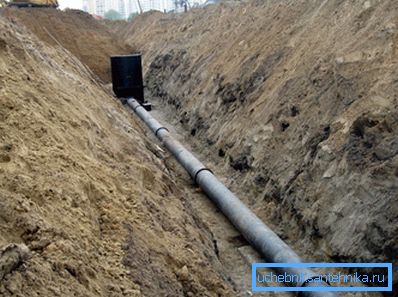
- Also, this group of methods includes laying of pipelines in underground closed trays: the system is located in a relatively isolated air chamber, the air in which cools down much more slowly.
- However, the ability to "hide" the pipe under the ground is not always. That is why in most cases the heat-insulating circuit made of porous materials is used. This circuit acts as a buffer zone, preventing the heat losses of hot liquid and protecting cold water and drains from freezing.
It is this methodology that we devote our detailed review.
Regulatory settlement
The basic document regulating the materials and methods used in the thermal insulation of various communications is SNiP 2.04.14-88. In this standard information is collected on the technology of insulation, as well as the basic requirements that are put forward to the protective circuits.
If we analyze the main provisions of this document, the SNiP on thermal insulation of equipment and pipelines contains the following recommendations:
- Warming should be a mandatory component of any system, regardless of the coolant temperature.
- For the equipment of the heat-insulating layer, both ready-made (below we will tell about the features of the “pipe in pipe” systems) and prefabricated structures can be used.
- When arranging insulation, it is imperative to provide for protection of metal parts from corrosion, since in this case rust will spread much faster.
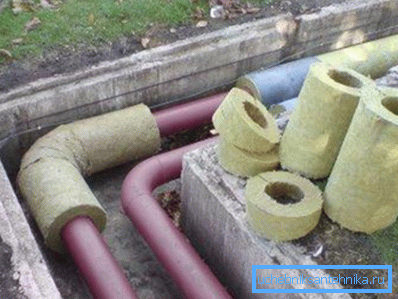
- The optimum is a multi-layer design of the circuit, which includes the insulation itself, fixed with the help of fasteners, vapor barrier and a protective layer of metal, dense polymer or nonwoven fabric. Also in some cases, the installation of a reinforcing contour is envisaged, the main task of which is to protect porous materials from crushing and to prevent deformations of the pipe itself.
Also in the document are formulas by which the thickness of each layer is calculated. Data on the minimum allowable power (for SNiP) of the heat-insulating circuit, we have collected in the table below:
| Features of thermal insulation | Minimum thickness, mm |
| When using fabrics, pierced canvases, cords | thirty |
| When using fibrous compacted materials | 40 |
| When warming with dense polymers, for pipes of small diameter (up to 40 mm) | 40 |
| The same for pipes of large diameter (over 40 mm) | 60 |
It should be noted that the main part of the requirements set forth in the standard concerns the arrangement of high-capacity heating networks, as well as main water supply systems and sewage pipes. But even if you are doing the construction of a water supply system or sewage system with your own hands, you should familiarize yourself with this document and, if possible, use the data provided in it when designing and installing.
Review of materials
Polymer materials
Speaking about the materials that are used to reduce heat loss, in the first place we usually think of foamed polymers. This is quite reasonable, since the range of such products is very wide, and therefore it will not be difficult to choose the variety that is most suitable for our situation.
First of all, such compositions deserve attention:
- PE foam. This insulation is characterized by high porosity, low density and relatively low mechanical strength. Usually PE foam pipe insulation is made in the form of oblong cylinders with a slit, which allows for quick installation even without special skills. The disadvantages of PPE insulation usually include rapid wear due to mechanical damage and low heat resistance.
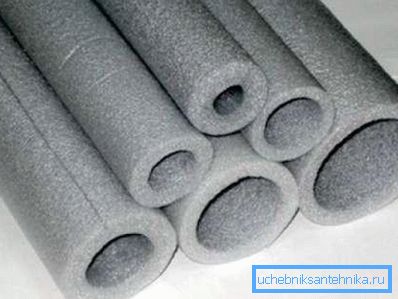
Note! To facilitate the installation of covers and to prevent the removal of the material should choose a model whose diameter corresponds to the diameter of the pipe.
- Styrofoam. It has low elasticity and considerable strength, because it is produced in the form of a “shell” of several segments. To connect the parts together at their edges, locks with spikes and grooves are made, which allows you to do without fasteners and get rid of the "cold bridges". It is more expensive foam, but also serves at times longer.
- Polyurethane foam. Usually used for the production of pre-installed insulation, but can be used in everyday life. Available in the form of "shells" of two or four segments, as well as in the form of insulating foam. The spraying of polyurethane allows you to provide effective insulation of communications of the most complex shape, while the resulting shell is sealed.
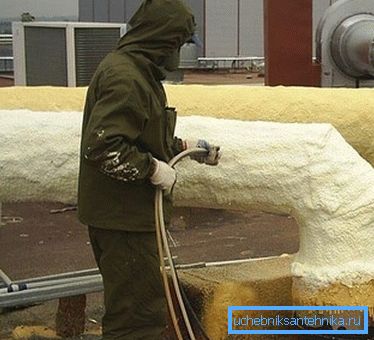
Tip! To polyurethane foam after polymerization is not destroyed under the influence of ultraviolet radiation, it is coated with either paint or non-woven cloth. When choosing a material it is very important to ensure that it has sufficient vapor permeability.
Fibrous materials
Not less (and in some cases more) popular than polymeric insulants are insulating materials based on mineral wool and its derivatives.
They have such advantages:
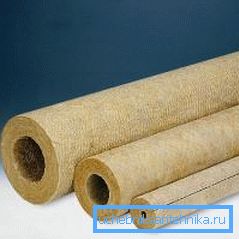
- Low thermal conductivity coefficient, which is ensured by a unique internal structure formed by a multitude of fibers.
- Considerable resistance to external factors, namely to heat, ingress of acids, alkalis, oils, etc.

Note! An additional plus is that the mineral wool shell does not damage rodents.
- The ability to maintain shape without installing an additional frame.
- Reasonable price.
At the same time, it should be noted that during the installation of such heat insulating circuits it is necessary to ensure that the material does not shrink and is reliably protected from wetting, since these effects can significantly reduce the effectiveness of its work.
Both mineral wool and polymer insulation shells often provide a metallized coating of aluminum or steel foil of different thickness. This coating acts as a heat shield, reflecting infrared radiation and reducing heat dissipation into the atmosphere.
High density constructions
Finally, a separate group consists of pre-insulated pipes for heat networks (the “pipe in pipe” system). They come with an already mounted heat-saving casing, and the task of the master is only to combine all the details into a single system.
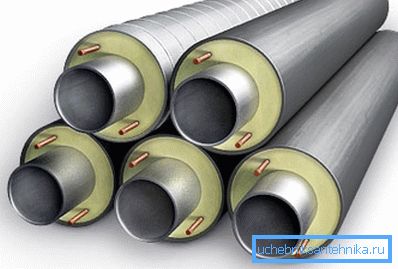
The main components of the construction of such pipelines are:
- The base is a metal or polymer pipe. It acts as a carrier element for the entire system, it can be manufactured using seamless technology, or by welding.
- The insulating layer, which is most often made of foamed polyurethane (PUF). As a rule, it is applied to the pipe according to the filler technology by filling the special formwork with the molten mass.
- Protective cover It is carried out from polyethylene (pipes PPU PE) or galvanized steel (PPU OTs). The first variety is intended for laying in the ground by the non-channel technology, the second is for placement in the open air.
- In addition, remote control wires - copper conductors, which allow to determine the condition of the whole pipe and precisely localize the areas where the insulation or support structure was damaged, are often laid in the thickness of the polyurethane foam insulation.
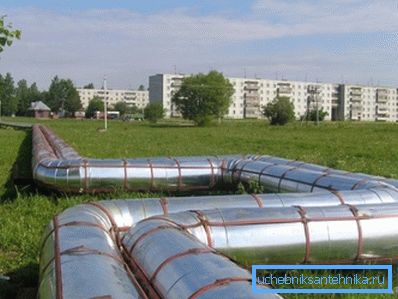
Pipes are shipped from the factory fully assembled and welded. Thermal insulating circuits are combined either with the help of special heat shrink sleeves, or by lining couplings of mineral wool with a foil layer.
Self-installation Tips
The complexity of the process of arranging insulation depends largely on the scale of the work. If within a private house you can cope in just a few hours, then you will have to work pretty hard when laying the highway.
Below we give instructions in which we will try to take into account all the key points.
We begin the description with the technology of insulation of pipes that are laid outside.
We serve the underground part as follows:
- At the bottom of the trench lay sewer trays made of concrete with high water resistance.
- We place the pipes in the tray, carefully sealing the joints.
- From above we put on heat-insulating covers, and then we wrap products with vapor-permeable fiberglass. For fixing use special polymer clamps.
- We close the lid with a tray, after which we cover it with soil that was removed from the trench. It is desirable to lay a clay-sand mixture in the gap between the walls of the tray and the edge of the trench, followed by compaction.
- If the tray is not used, then the pipes are laid on a layer of compacted soil filled with sand and gravel.
The work on thermal insulation of the external pipeline looks a little different:
- To begin, clean all parts of rust, removing it using a metal brush.
- Then we treat the pipes with an anti-corrosion compound.
- At the next stage, we either install the polymer “shell”, or we wrap each pipe with mineral wool roll insulation.

Note! You can also apply a layer of polyurethane foam or several layers of ceramic insulating paint. In the case of paint insulation there is an opportunity to save on anti-corrosion treatment.
- In the same way as in the previous case, we set up a protective layer, only here one can also use a foil-coated film with polymer reinforcement.
- To fasten the entire structure, we use steel or plastic clamps.
It is easiest to heat the internal pipelines: we put polyethylene foam shells on the corresponding diameter on them and fix them with foil tape or plastic fasteners.

Conclusion
Thermal insulation of equipment and pipelines should be carried out according to a standard scheme with the use of appropriate materials. Only in this case, the hot water will remain hot all the way from the boiler room to the house, and the cold water will not freeze even in extreme cold. In more detail, the issues of insulation communications are discussed on the video in this article.